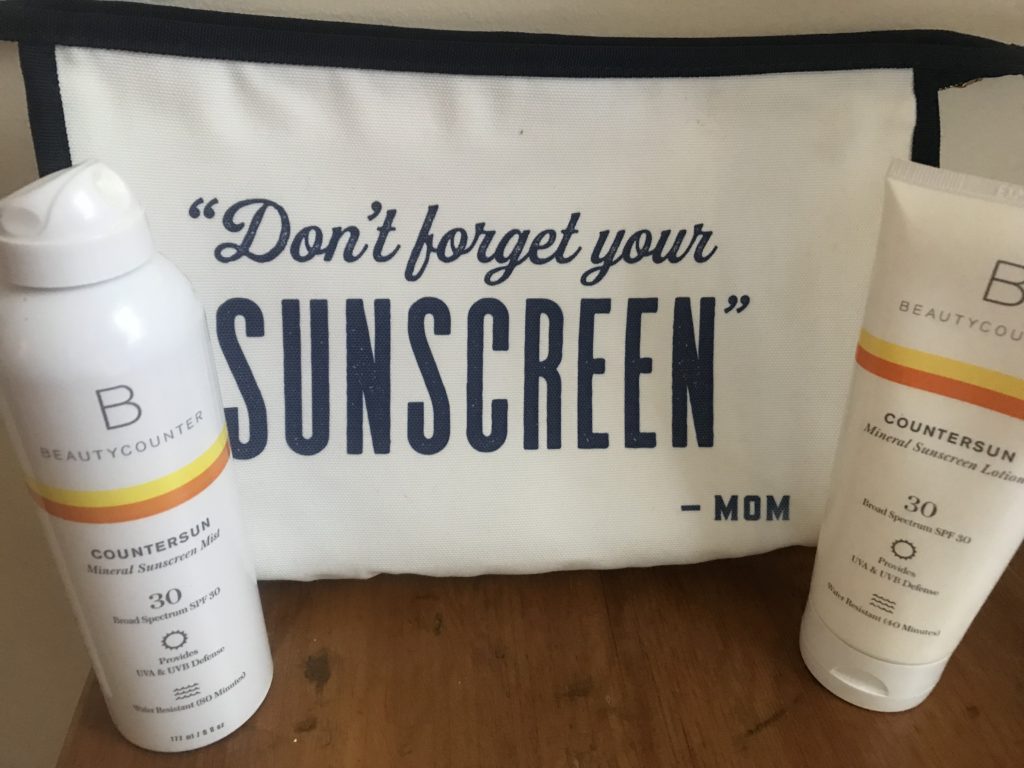Rain, Rain will go away and sun will be here to stay!
When the sun is out and on cloudy days – we need to wear sunscreen.
“There are over five million cases of skin cancer diagnosed every year in the United States making it the most common cancer. About 90 percent of non-melanoma skin cancers and 85 percent of melanoma cases are associated with exposure to ultraviolet radiation from the sun.” (Source Beautycounter).
Lately, there’s been a lot in the news about the importance of wearing “safe” sunscreen. But, what does “safe” and “healthy” sunscreen really mean?
Basically, there’s 2 types of sunscreen: mineral and chemical.
Mineral sunscreens protect us from harmful UV rays by sitting on top of your skin. Chemical sunscreens work by absorbing into your skin.
Mineral sunscreens do not harm our environment – chemical ones do – which is why Hawaii and many places in Mexico do not allow chemical sunscreen – and more places are looking to ban it.
To make life easy — you can order your healthy and safe sunscreen with me — and now Beautycounter has a “tinted” Countersun Mineral sunscreen in both lotion and mist. We also provide travel sizes in the non-tinted Countersun as well.

Here’s helpful information to look for when shopping for your sunscreen:
What to look for:
Broad Spectrum: This means the sunscreen protects against both UVB and UVA rays. UVB rays are the rays that burn the skin and cause sunburn, but UVA rays are just as harmful – they penetrate deeper into your skin and can accelerate aging. A product’s SPF (sun protection factor) tells you how much the product protects you from UVB rays; the SPF does not tell you how much it protects you from those dangerous UVA rays. Both UVA and UVB rays can cause skin cancer. Even if you don’t leave the beach with a sunburn, UVA rays can still do some major damage, so it’s best to make sure you’re protected from both by choosing a broad spectrum sunscreen.
Mineral Ingredients: Zinc oxide and titanium dioxide are the mineral ingredients to look for when shopping for sunscreen. They protect against both UVB and UVA rays and don’t seep into your bloodstream. Because they work by sitting on the surface of your skin to provide a protective barrier, they start working right away. Chemical sunscreens, on the other hand, need to be applied 20 minutes before going out into the sun. As a bonus, zinc is also known to help calm and soothe skin.
Chemical Synthetic Ingredients: Most common sunscreens fall under the category of chemical sunscreens and work by seeping into your skin and absorbing the sun’s rays. Common synthetic ingredients include oxybenzone, octinoxate, avobenzone, octisalate, octocrylene, and homosalate. Basically, if you can’t pronounce it, you probably shouldn’t be lathering it all over your skin. Not only are these ingredients more likely to cause allergic skin reactions, studies have shown they can seriously mess with your hormones. Plus as I mentioned above, they’re bad for the environment –two of these ingredients, oxybenzone and octinoxate, have recently been banned in Hawaii because they’re so harmful to the coral reef.
Vitamin A: You may be familiar with vitamin A, or retinyl palmitate, an ingredient often used in skincare products for its antiaging benefits. While it works great as a night cream (and should always be followed by sunscreen the next day), retinol is not something you want to be putting on your skin as you prepare to soak up some rays. Research shows that sunscreens containing vitamin A can actually accelerate the growth of lesions and tumors.
Now — see you at the beach and/or the pool!
For more information on living your healthiest and highest self — thru fitness, health coaching and clean living; check out my website.
